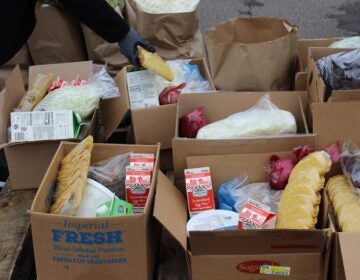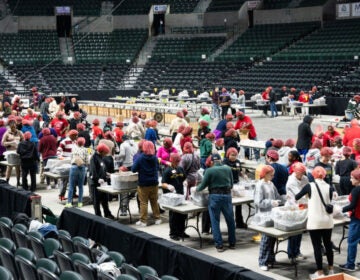The excruciating challenge of being a high school athlete without enough to eat
Food insecurity causes drastic and unhealthy coping solutions for many high school athletes in and around Philly. But many have overcome its consequences.
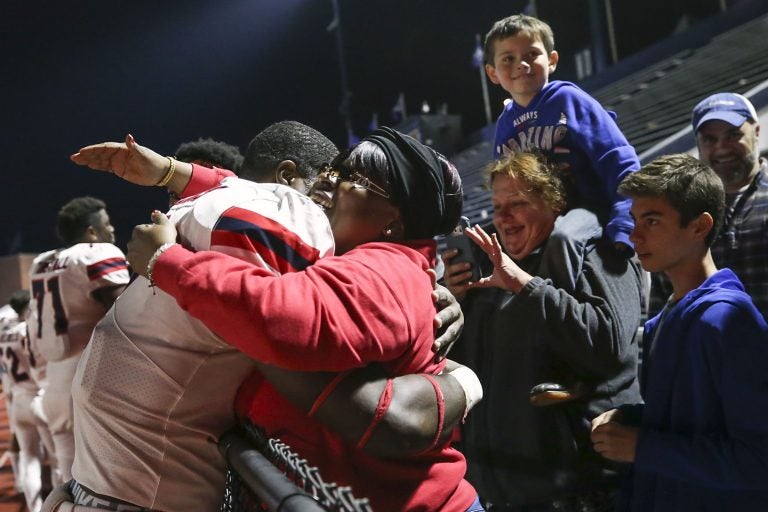
Stony Brook defensive lineman Casey Williams hugs his mother, Zina Williams, while surrounded by friends and family after his team defeated Villanova on Saturday, Oct. 26, 2019. (Heather Khalifa/The Philadelphia Inquirer)
This article originally appeared on The Philadelphia Inquirer.
His stomach was often empty. His body was always weary.
Tragedy, frustration, and pain had nearly cost Casey Williams his Division I football promise.
Yet he believed a college football scholarship meant a better life.
But to cope with pangs of hunger that made sleep improbable, Williams, a 2016 South Philadelphia High School graduate, exercised until exhaustion just so his beleaguered body could rest.
Greg Garrett, 46, current trainer of Philly-born NBA veterans Marcus and Markieff Morris, recalled he once ate gum off a sidewalk rather than walk the three miles to Sayre Junior High School on an empty stomach.
Food insecurity has caused high school athletes in the Philadelphia area to cope with hunger in drastic, often unhealthy ways for generations.
A federal government term, food insecurity is defined as “lacking consistent access to enough food to live an active, healthy life.” It affected 37.2 million people, including 11 million children nationally in 2018, according to the most recent federal report.
New York-based nonprofit Hunger Free America reported that between 2015 and 2017 more than 176,000 children in the metropolitan Philadelphia area, including surrounding suburbs, lived in food-insecure homes. High school athletes in those households still competed for athletic scholarships that many believed would help them transcend poverty and despair, escape violence, further their education, and build a better future.
“Playing in college was a huge goal of mine,” said Williams, 22, now a redshirt sophomore defensive end at Stony Brook University. “But I never thought it would happen because my life was a lot of tragedy.”
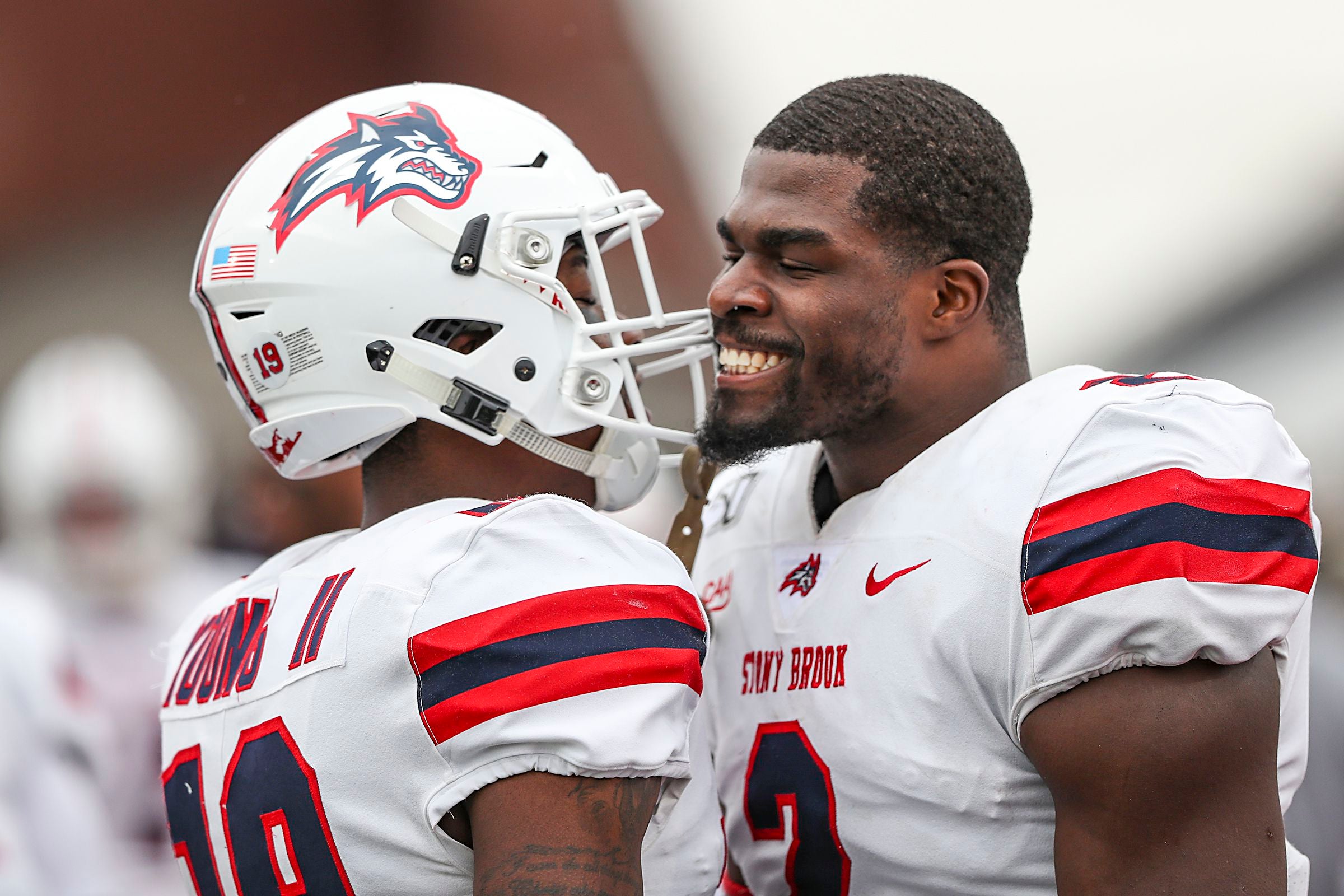
Causes of food insecurity
A September report released by the U.S. Census Bureau revealed the city’s poverty rate dropped to its lowest levels since 2008 while median household incomes rose. Philadelphia, however, still has the highest rate of poverty among the 10 most populous U.S. cities.
A correlation between poverty and food insecurity certainly exists, says Kate Scully, director of government affairs at Philabundance, the area’s largest hunger-relief agency.
But, Scully adds, life above the poverty line alone does not preclude food insecurity. For a family of three in 2018, the federal poverty line was $20,780. Currently it is $21,330. Unexpected costs, she says, also send those living above the poverty level into Philabundance partner agencies in search of food.
Food deserts (neighborhoods that lack healthy food sources), and food swamps (areas with an abundance of unhealthy food sources) are also factors in food access.
Still, recent national and local reports suggest food insecurity is on the decline. But antihunger advocates warn that continued Trump administration attempts to cut Supplemental Nutrition Assistance Program benefits (known as SNAP) could reverse that progress.
“Nearly half of the 40 million people getting SNAP in this country are children,” Scully said in a phone interview. She added later, “Any time you cut people off SNAP you’re also taking food out of their refrigerators, off their tables …”
The U.S. Department of Agriculture manages SNAP. Potential USDA rule changes suggested by the Trump administration, advocates argue, could cause 3 million Americans to lose benefits. That includes 200,000 Pennsylvanians and 250,000 New Jersey residents. Government officials argue the rule changes would close eligibility loopholes that could save $2.5 billion a year from SNAP.
It also could mean increased hardships for area high school athletes whose eligibility for free school meals is determined in part by their family’s SNAP eligibility.

Coping with hunger
Simon Gratz graduate Nydair Rouse, 24, who was drafted by the Green Bay Packers, filled his stomach with water as a child to make his belly feel full.
Charles Fryson, now 23, played high school football at Strath Haven. After his mother and grandmother died when he was in junior high school, Fryson often skipped meals at school and saved his lunch money so both he and his grandfather could eat dinner at home.
“That was just stuff I had to deal with every day,” Fryson says. “Then I would have to figure out, ‘All right, how am I going to survive throughout the week without having lunch at school?’ ”

In Philadelphia County alone, 73,000 children coped with food insecurity in 2017, according to Feeding America, the nation’s largest domestic hunger-relief organization. That was one of the reasons area athletes were struggling to survive while competing for athletic scholarships the National Collegiate Athletic Association says only 2% of high school athletes earn.
Casey Williams estimates that between junior high and high school he moved, for various reasons, six to eight times. That does not include staying at friends’ houses, or spending the night in the Olney area with relatives or friends when domestic violence erupted at home.
Where he rested his head at night could mean at least an hour-long SEPTA commute to South Philly in the morning. Once inside the building, Williams depended on the free or reduced-price meals provided for breakfast and lunch by the School District of Philadelphia. The school day then included a struggle to stay focused in class made worse by distractions from other students he says also had tumultuous home lives.
At least football practice — nearly 10 hours after his day began — provided a much-needed release.
But the hour-long commute “home” meant he sometimes returned between 7 and 9 p.m. And that is if the abuse his mother, Zina, endured did not send both in search of shelter elsewhere, she said.
“My family wasn’t perfect, so I bounced around from family member to family member,” he said. “Having to stay with different friends, not having my own room, my own house all the time. Coming home from practice — I’m talking about starving — and I had to just drink water or do whatever I had to do to go to sleep.”
Often, more exercise helped.
“I would just work out,” Williams said. “If my muscles are super sore, I’m not focused on my hunger. When my muscles are sore, that’s the only thing on my mind and I’d just go to sleep.”
The next day he did it all again.
“Imagine having an empty stomach,” Williams said, “and you didn’t eat all night, and you’re tired. Then you got to wake up. So you go to school on an empty stomach and [a student] says something crazy to you and he looks like he has money. He says something like, ‘Oh, why your shoes busted?’ And you, with an empty stomach, you know your shoes are busted and you don’t want nobody to say nothin’. You could just snap. But I had an OK temper growing up. I just saved it and put it in my back pocket and snapped in practice.”
His stomach often empty, hunger became his fuel.
“That was my motivation,” Williams said. “I wasn’t trying to be hungry no more, so I came in every day, every workout, every game, every practice, and gave it my all because I wanted to go into stores [one day] and just get what I wanted off of hard work …”
Effects on behavior and performance
The brain is a thief. Shala E. Davis, chair of the exercise science program at East Stroudsburg University, says the brain’s preferred fuel is glucose, which the human body can get from eating regularly.
So when Casey Williams sat in class, stomach empty, struggling to pay attention, struggling to stay awake, his brain could have turned burglar.
“It’s about neurons firing,” Davis said. “It’s about making decisions. It’s about problem-solving. So the brain, which is a very intricate organ, needs fuel and it will rob fuel from other parts of the body and then that becomes a problem as well.”
Coping strategies employed by Williams, Rouse, and Fryson are not uncommon. They also come at a cost.
Irritability and hostility can increase. Academic performance can decrease. Predictably, athletic performance also can decline. Perhaps less predictably, however, injuries can increase.
“Your body can go into what’s called ‘survival,’ ” said Davis, a former field hockey and track athlete at the University of Delaware. ”It can think you’re on a deserted island.”
Instead of preferred sources, she said, the body can rob resources elsewhere. The metabolism can slow. Less fat may burn. Muscle can sometimes burn instead, further degrading what athletes already deplete and increasing the likelihood of injury.
Williams recalls injuries at least once a year in all four years of high school, including his freshman season at now-closed Bok Tech. A knee injury his senior year kept him from the majority of South Philly’s season.
“Some injuries can be acute, but in some cases,” Davis said, “some injuries can have lifelong impacts. I think that’s why we have responsibilities in schools to educate kids how to eat appropriately and then that impacts mental, emotional, and physical health, which is really the whole person when it comes to total wellness.”

Help wanted, help needed
Chelse Hall, 35, is a well-known youth basketball coach for boys and girls in the Philadelphia area. Hall started the Right Turn Youth Academy about four years ago. She says RTYA has served about 5,000 kids through various leagues, camps, and travel teams. About 30 of the 47 girls in her program, she says, live in food-insecure households.
Hall supplies the girls with food, shelter, and backpacks that include feminine hygiene products. No girl gets singled out.
“The more I get involved, the more my heart aches for these kids,” Hall says, “but also the more I’m motivated to keep going because you feel for these kids that just don’t have anything.”
In the Philadelphia Public League, Frankford High School football coach Bill Sytsma had about 55 players on his varsity team during the 2018 season. More than half, he said, lived in food-insecure households.
In June 2019, he turned the team’s locker room into a food pantry and sanctuary from area violence.
John Davidson, Mastery North High School football coach and assistant principal, provides food before every game, which is not uncommon in leagues across the area. Less common, however, is that Davidson’s program also provides food after games so players don’t go home hungry.
Martin Luther King High School football coach Malik Jones uses applications on his phone to send money to players who are hungry at home.
“If I’m going to push them the way I need to push them,” Jones says, “I think it’s my job to fill them back up, if they can’t fill themselves.”
In the Philadelphia Catholic League, McDevitt basketball coach Will Chavis, also a health teacher at the school, hosts team parents to advise what foods players should and should not eat.
In the suburbs, Radnor boys’ basketball coach Jamie Chadwin said his program and the school community at large has helped Radnor athletes in need.
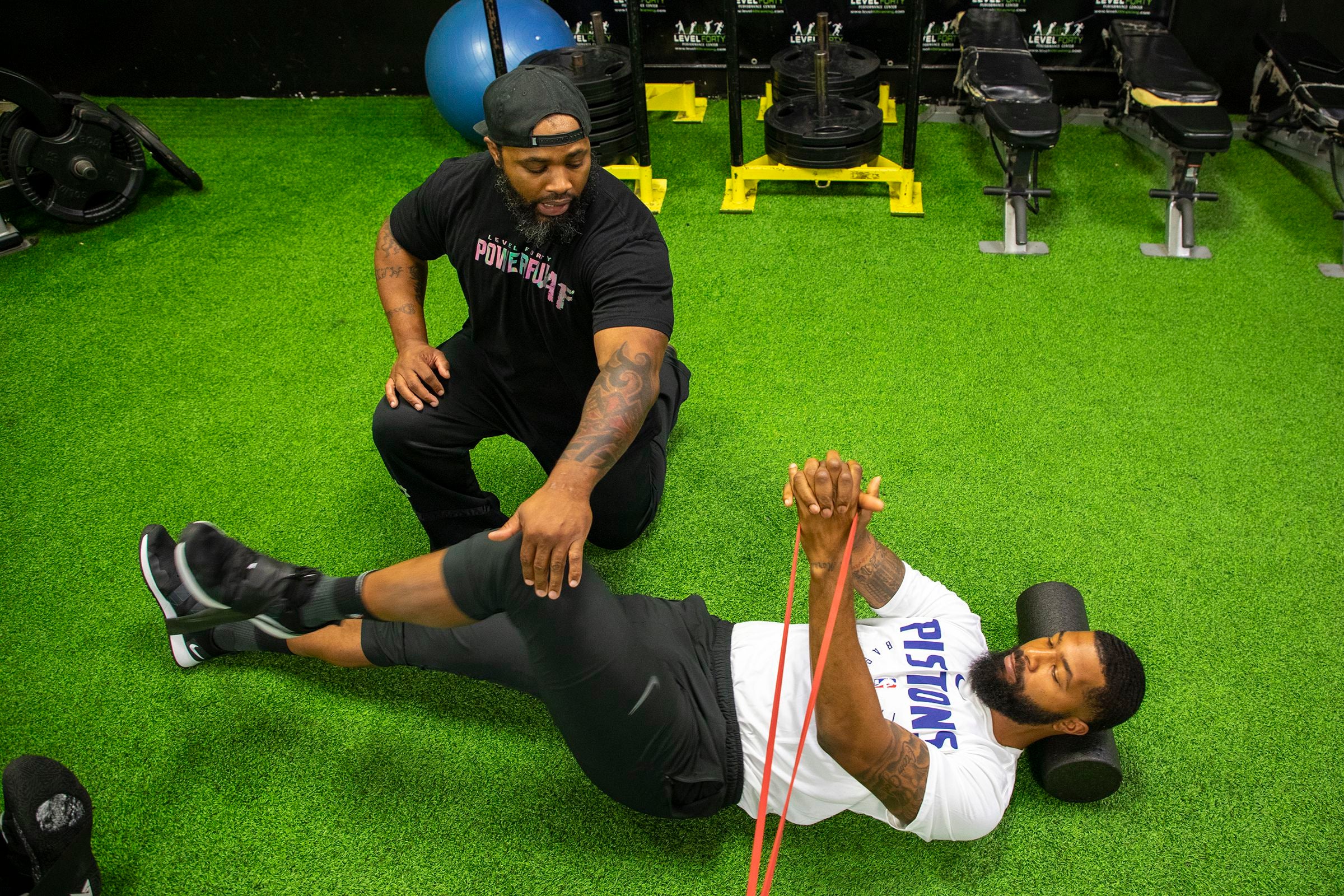
Overcoming food insecurity
Greg Garrett tells his clientele, “It doesn’t make sense to have a Bentley body and a Toyota engine,” when he addresses eating habits. In addition to a masseuse and trainers on his staff at Level 40 Training and Performance Center, he also employs a chef.
That doesn’t stop Garrett from his daily soda and cupcake.
“A lot of the things I do are a reminder of what I came from,” Garrett says.
Like that gum on the sidewalk so many years ago. It looked fresh, Garrett remembered, as if someone had recently tired of its flavor. It was the 1980s and Garrett awoke with the same empty stomach he often took to bed. The nearly three-mile walk from his home near 38th Street and Haverford Avenue to Sayre Junior High School was hard enough. He ducked down certain streets to avoid the smell of food cooked in places where he couldn’t afford to eat.
Sometimes he strode with cardboard in his soles so his socks stayed off the pavement.
A piece of gum caught his eye. He still remembers the spot on 51st Street.
“It still looked juicy,” he said. “And it had a leaf on top.”
Garrett took a knee, pretending to tie his shoe. He scooped the gum, brushed away the leaf. After a fake cough, he popped it in his mouth.
It took a few blocks to realize what he had done.
“At that point I was in survival mode,” he said. “That was probably one of my lowest points. I vowed that when I got older that would never happen again.”
Like Casey Williams, the struggle fueled Garrett.
“I don’t regret anything,” he said. “I’m glad that I went through that because it actually shaped me and molded me into who I am today. No matter how tough situations get for me, I don’t panic.”
He played linebacker and running back at West Philadelphia High School (1991). He later became a school police officer at George Washington High School and used that school’s gym to stay in shape while he played semipro football.
Washington players noticed his intense workouts. Sharrif Floyd was one of them. Floyd, a 2009 graduate, also dealt with food insecurity. Floyd and his teammates had found their trainer. Northeast High School football star Deion Barnes, who went on to play at Penn State, did, too.
Floyd later became a first-round pick in the 2013 NFL draft. Barnes eventually signed with the Jets as an undrafted free agent in 2015.
As more athletes sought his services, Garrett realized he could build a business. He eventually went to Bryant University and studied exercise science. The goal was to own a gym by 40. At 39½, he turned the key to his space in King of Prussia.
‘The bigger picture’
Nydair Rouse watched Germantown High product Will Parks ascend to the NFL and believed he could, too. Before that, Rouse was an impressionable and hungry kid who knew drug dealers got rich on the corner.
“You see the designer clothes and you think that’s the lifestyle,” Rouse said. “It’s easier to get a gun than it is to get a scholarship.”
“I could have made more money on the corner in one day in two or three hours down in Kensington than I could at a job in a week,” Rouse added. “That’s lust. You have to teach yourself that it’s a process. …You’ve got to see the bigger picture more than anything.”
I remember being in high school I would be at the field for like 12hrs because I ain’t have no money and I didn’t wanna be in the streets. I would just imagine my life being where it is today! It’s hard making it out of North Philly.
— Nydair Rouse (@Ptbyola) July 10, 2019
His mother, Shamika Rouse, made sure his vision stayed clear even as she worked double shifts in a nursing facility to feed Rouse and his three sisters.
With consistent access to food at West Chester University, he eventually gained nearly 30 pounds of muscle. He also woke up without hostility, was less angry and irritable throughout the day, and saw the world differently. He became, he believes, the person he should have been all along and now hopes to inspire others growing up as he did.
“If you talk to one kid and one listens,” Rouse said, “it can really make a difference.”
He did not make the Packers final roster, but survived until the final day of training camp. In October, he was drafted by the XFL’s New York Guardians.
Fryson’s uncertain path
Fryson attended Valley Forge Military College, but he struggled academically and left school. He was a client at Level 40 in March, waiting to try out for the Canadian Football League.
He knew the odds were against him. In some ways they always had been. In 2007, his mother, Evelyn Holmes, died after battling breast cancer. About a year later, his grandmother, Isabel Holmes, also died.
Fryson grew up in households that lacked running water, sometimes had no refrigerator, no heat. He and his grandfather, William Holmes, moved often. They still do.
“I remember we had to boil water on the stove to put it in the tub, and then wash [ourselves] like that,” Fryson said. “I was still in high school. I remember we had to wash dishes in the tub. Wash clothes in the tub.”
He never heard from the CFL. He might pursue semipro football, go back to college, or continue trying out for teams.
His grandfather, now 80, overcame lung cancer about a year ago, Fryson says. Now they both live in Media with Fryson’s aunt while Fryson works night shifts as a security guard and saves money to get him and his grandfather a place of their own.
Williams watched and learned
Bok Tech product Jihad Ward said he also dealt with food insecurity growing up in Philadelphia. Ward is a linebacker with the Baltimore Ravens this season. Casey Williams watched Ward’s workout videos on Instagram and dreamed of a better life for himself, for the kids growing up as he did, and for his mother.
Williams got an internship as a personal trainer last spring at a gym near Stony Brook. He has also taken health and nutrition classes.
When he comes home from college, he goes back to Focused Athletics, a local nonprofit that mentors, feeds, trains, teaches, and inspires area athletes.
“You’ve got to see it before you can believe it,” he says. “That’s my motto. So I try to do everything possible to succeed and then come back here and show these guys that it is possible.”
He also calls his mother with health tips he learns in class. Zina Williams has always been “heavy,” she says, and was teased as a child growing up in North Philadelphia. Her weight, she says, has contributed to other health conditions. Her mother was also heavy and died at 47 after a sudden heart attack. So, Zina Williams changed her diet. She has plans with her son.
“It’s so hard sometimes that I think I can’t make it,” she said in a phone interview, “but I keep on thinking, ‘I got to make it because of [Casey].’ ”
Besides, she’s learned something about herself, too.
“That I am stronger than I think I am,” she said with a confident chuckle. She wants to become a motivational speaker for women who have survived abuse.
She has seen only a handful of Stony Brook games, but on Oct. 26 she watched the Seawolves’ dramatic 36-35 come-from-behind victory at Villanova. Her son made his 15th consecutive start and finished with four tackles.
“He’s looking for me to be there to see him make it all the way through [college],” she said. “So I got to stand strong. We’re standing strong for each other.”
 The Philadelphia Inquirer is one of 21 news organizations producing Broke in Philly, a collaborative reporting project on solutions to poverty and the city’s push toward economic justice. See all of our reporting at brokeinphilly.org.
The Philadelphia Inquirer is one of 21 news organizations producing Broke in Philly, a collaborative reporting project on solutions to poverty and the city’s push toward economic justice. See all of our reporting at brokeinphilly.org.
WHYY is your source for fact-based, in-depth journalism and information. As a nonprofit organization, we rely on financial support from readers like you. Please give today.


